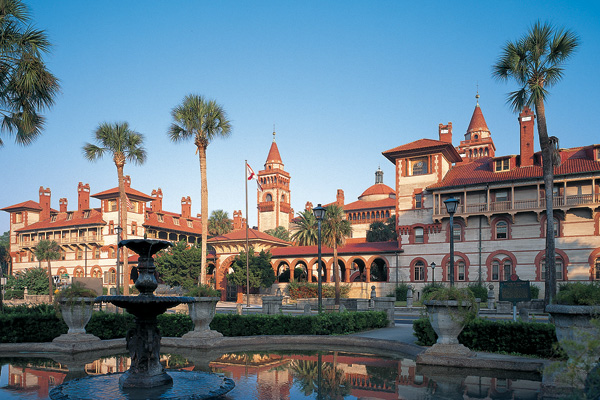
More than 100 years after Florida’s railroad boom brought the posh set to St. Augustine, this former Spanish colony just south of Jacksonville still holds Old World allure. In the morning, when the streets are quiet and the sun begins to warm the red tile rooftops, it’s easy to imagine turn-of-the-century snowbirds flocking to the resorts that railroad baron Henry Flagler built here in 1888.
Winter sun-seekers still come to St. Augustine, the oldest continuously occupied European settlement in the nation. (Ponce de León landed here in 1513, and the city was founded in 1565.) In the historic district, today’s visitors can tour homes dating from the 1700s and browse the shops and galleries along brick-lined Aviles Street. Families won’t want to miss a pirate-themed sail on the Black Raven, while couples gravitate toward a sunset cruise on the Schooner Freedom, a replica of a nineteenth-century blockade runner. There’s also year-round, world-class golf: The Sawgrass Marriott Resort in nearby Ponte Vedra Beach hosts the PGA Tour’s Players Championship, while the World Golf Village boasts the only course jointly designed by Arnold Palmer and Jack Nicklaus.
Flagler’s flagship resorts, the Ponce de Leon and Alcazar, no longer welcome overnight guests, but both are open to the public as Flagler College and the Lightner Museum, respectively. At the Lightner, decorative arts such as gilded furniture and musical instruments fill former Turkish baths and ballrooms, while the old indoor pool serves as the museum’s cafe. At Flagler, guided tours lead up a marble and onyx stairway to the breathtaking dining hall, ringed by seventy-nine Tiffany windows.
These days, enjoying St. Augustine’s mild winters takes just a six-hour drive from Atlanta, an improvement over the day-and-a-half train journey of Flagler’s time. Gilded Age visitors did have one advantage, though: When they came to St. Augustine, they stayed the entire winter. You may be tempted to follow suit.
DO
Start the day with a waterfront stroll to the Castillo de San Marcos National Monument, a sprawling stone fort that dates from 1672. At the Dow Museum of Historic Houses, visit nine homes within a city block. Stroll down pedestrian-only Saint George Street to the Taberna del Gallo (904-825-6830), a candlelit 1740s tavern where staff in period dress serve house-made sangria.
STAY
Lodging within the historic district is worth the cost, both for the Mediterranean ambience and the convenience of walking to most attractions. Casa Monica, a restored 1888 hotel once owned by Flagler, offers modern comforts along with Old World opulence. Bed-and-breakfast inns abound; At Journey’s End has a pet-friendly suite.
EAT
Celebrate St. Augustine’s Spanish heritage with tapas at the Tasting Room, or head to 95 Cordova in the Casa Monica hotel, which offers a five-course tasting menu with wine pairings in an elegant Moorish-inspired setting. Waterfront dining is the draw at a pair of casual eateries, Cap’s on the Water and Saltwater Cowboys, both on the Intracoastal Waterway.
Photograph courtesy of Flagler College
Advertisement













